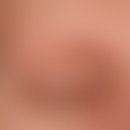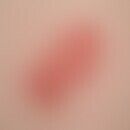DefinitionThis section has been translated automatically.
Use of all types of freezing techniques for the targeted and controlled destruction of pathologically modified tissue. Cryosurgery is mainly used in the therapy of skin tumours, mostly by freezing with liquid nitrogen.
Optimum cell destruction can be achieved by very rapid freezing with a slow thawing phase. This results in so-called homogeneous nucleation, i.e. intra- and extracellular ice crystal formation with destruction of the cell membranes.
IndicationThis section has been translated automatically.
You might also be interested in
ImplementationThis section has been translated automatically.
Punch biopsy for diagnostic confirmation. Only tumours or skin changes that have not exceeded the middle corium are suitable for cryosurgery. For this reason, a sonographic examination should be performed before freezing to determine the thickness. A distinction is made between:
- Closed contact method: A metal stamp of suitable size is placed on the lesion so that the largest possible area of the probe is in contact with the tumour surface. The liquid nitrogen is then introduced into the system. This allows rapid cooling of the metal punch down to -170 °C.
- Open spraying method: Liquid nitrogen is sprayed directly onto the area to be treated. Before starting therapy, the area to be treated should be briefly sprayed with a tetramethylthiuram disulphide (thiram) film (e.g. Nobecutan); a silicone moulage (e.g. silicone kneading mass, Orbis-Dental Frankfurt/Main) can be modelled well on the skin surface pre-treated in this way to distinguish the tumour from the surrounding healthy skin. The tumour can then be frozen in a direct nitrogen stream until the necessary temperature is reached at the base of the tumour. Caution! Liquid nitrogen can run under the moulage!
Temperature monitoring is necessary for both cryosurgical modalities. A thermal probe is advanced from the healthy skin to the base of the tumour (prior sonographic control of the tumour invasion). During tumor freezing, a temperature of -20 °C to -30 °C must be reached at the base. After reaching the necessary temperature, the freezing process is interrupted. The tissue gradually thaws out again and is immediately subjected to a 2nd freezing cycle. Then dry dressing. Cryoreaction: Initial reddening, within the first 24 hours strong exudation and accompanying oedema. Crust formation. Duration of wound healing depends on the number of freezing cycles and on the location of the treated area; on average about 2 weeks.
- In actinic keratoses, toxic epidermolysis is the aim. In this case, it is sufficient to freeze the skin so that a weak film of ice covers the area to be treated. After thawing, the freezing cycle is repeated in the same way.
- An analogous procedure is to be chosen for cryo peeling. Here, care must be taken to ensure that the area to be treated is frozen evenly so that homogeneous epidermolysis is achieved.
ContraindicationThis section has been translated automatically.
- Extended scerodermiform basaliomas
- Tumours on the hairy head
- Tumours on the ala nasi and nasolabial side in younger patients
- Collagenoses (except CDLE)
- M. Raynaud
- cold urticaria
- Cryoglobulinemia
- Invasive and larger tumours near the eye
- Invasive tumours near the auditory canal.
LiteratureThis section has been translated automatically.
- Altmeyer P et al (1989) Dermatological cryosurgery. Nude. Dermatol 15: 303-311
- Castro LG et al (2003) Treatment of chromomycosis by cryosurgery with liquid nitrogen: 15 years' experience. Int J Dermatol 42: 408-412
- Chiarello SE (2000) Cryopeeling (extensive cryosurgery) for treatment of actinic keratoses: an update and comparison. Dermatol Surgery 26: 728-732
- Drake LA et al (1994) Guidelines of care for cryosurgery. J Acad Dermatol 31: 648-653
- Cook DK et al (1994) Complications of cutaneous cryotherapy. Med J Aust 161: 210-213
- Kokoszka A et al (2003) Evidence-based review of the use of cryosurgery in treatment of basal cell carcinoma. Dermatol Surgery 29: 566-571
- Kuflik EG et al (2000) Millenium paper: history of dermatologic cryosurgery. Dermatol Surgery 26: 715-722
- Yeh CJ (2003) Treatment of verrucous hyperplasia and verrucous carcinoma by shave excision and simple cryosurgery. Int J Oral Maxillofac Surgery 32: 280-283
- Zouboulis CC (2015) Cryosurgery in dermatology. Dermatologist 66: 834-848






